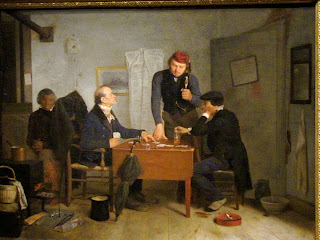



Starring: George Clooney, Vera Farmiga, Anna Kendrick, Jason Bateman
Written by Jason Reitman and Sheldon Turner
Directed by Jason Reitman
Grade: A/A+
Up in the Air doesn’t need acclaim from a mere Banjo review; it’s doing fine on its own. But I do want to pile on about how refreshing it is to see a film that treats its audience like adults. Even if we’re not quite up to the adulthood offered by our president, we should thank him for the gesture, and now we can applaud a similar respect for us from a movie.
Up in the Air is an entertaining film with a plot that moves and characters that amuse and appeal. But it’s also a meditation on our economy, and its critique of corporate coldness and cowardice goes way beyond fluff and charm.
With George Clooney as the male lead, I expected one more dose of urbane, wry, skinny-sexy, magically likable leading man. And like most leading men, Clooney is once again more Clooney than any character he plays. But in
Michael Clayton and now in
Up in the Air, that’s more than enough. His character, Ryan Bingham, is something of a thinker, albeit in a cynical vein. Add to that the good plot and meaty theme, two great female leads and a flawless supporting cast, and Ryan Bingham, despite all that winking and crooked grinning, has gravitas; we care about him.
The new-to-me amazements here are Vera Farmiga as the match for Clooney in both sexiness and wit, plus Anna Kendrick as Natalie Keener, the diminutive, aggressive, spunky, bouncy, cunning foil and challenger to Clooney’s Ryan Bingham. Bingham and Keener work for an Omaha company that flies “consultants” all over the nation—hence “up in the air”—to fire people (hence “up in the air” people) whose employers lack the spine for messy face-to-face encounters.
In a comparison that’s only slightly strained, Ryan Bingham’s job is like that of the two soldiers in
The Messenger (see Banjo52 on Dec. 18 and Dec. 28), who go door to door to inform families that their soldier is dead. Clooney’s clients are merely unemployed, not deceased, not yet, but the rehearsed skill sets of the messengers are uncannily similar: maybe downsizing is that much like slaughter.
From the plot’s believable turns, the main characters emerge and develop as people we cannot entirely love or hate—just like life, one could argue, if one is in the company of adults.
Ryan Bingham is not only experienced and good at firing people, but he also takes pride in his work, including his lifestyle on planes, in airports and hotels. Home, family, and other schmaltz are empty, bumpkin notions to him; they are cages, especially since his company is based in Omaha and his roots are in northern Wisconsin. He’d much rather be “up in the air.”
Enter perky Natalie Keener (Anna Kendrick), who is perhaps “keener”—fresh out of college, with a cost-cutting plan of firing via computer conferences. If only it weren’t for the pesky humanity of the victims and the threat to Ryan Bingham’s jet-set lifestyle—under the Keener plan, he would be grounded.
Then enter Vera Farmiga as Alex Goran (is she gore-ing people?) as the love interest for Ryan Bingham. (Where, by the way, have they been hiding Vera Farmiga? I’ve seen her here and there. But now
I see her).
The farthest thing from a Barbie clone, Alex is a knockout in her way, on her terms, with intelligence, charm, mystery, wit and some depth of character, it seems. It’s absolutely believable that a cosmopolitan leading man would find her fetching and compatible—in intellectual and professional terms, as well as sex appeal. It’s one of the more fascinating screen romances I’ve seen in a long time: two attractive, dubious characters who seem to deserve each other.
Farmiga and Kendrick impressively
become their characters. Alex and little Natalie are not especially admirable, but neither can we dismiss them as icy, one-dimensional villains. In fact, we’re usually glad to be in their company, for entirely different reasons. Men over 40 will want to father Ms. Kendrick and knock off Clooney in pursuit of Ms. Farmiga.
These women make perfect companions for Clooney’s Ryan Bingham. Alex is at least his equal in secularity and sexiness; maybe that explains her androgynous given name. On the flip-side is Kendrick’s unusual blend of protégé and professional rival.
The current economic crisis, plus America’s decades-long tendency toward downsizing ordinary folks while bloating our fat cats
ad nauseum, plus the older, more encompassing theme of cold corporate bastards (one of whom is the convincing Justin Bateman)—all this is handled with restraint and chilling plausibility.
So, if you want simplistic manipulation, go see
The Blindside; it’s an enjoyable, tepidly original yanking of the heartstrings, and you’ll probably feel good both during and after, as I did. On the other hand, if you think you can handle adulthood on film, but maybe not quite such darkness as
The Road or
The Hurt Locker, choose
Up in the Air. It goes down smoothly, yet will give you plenty think about, if you let it in.
* *



































































